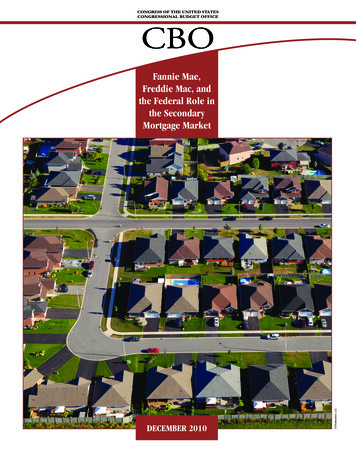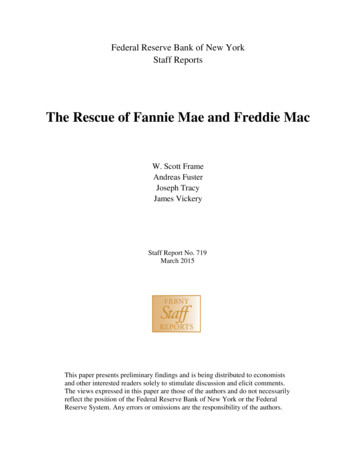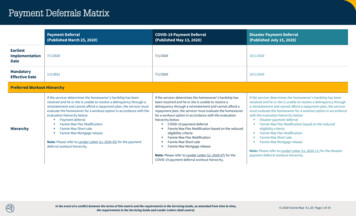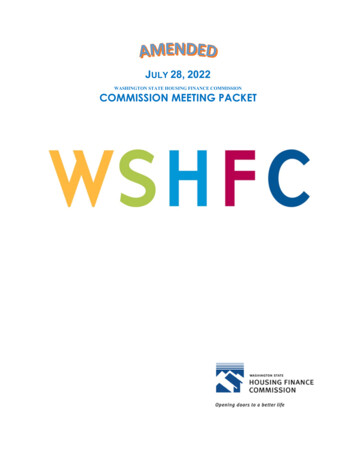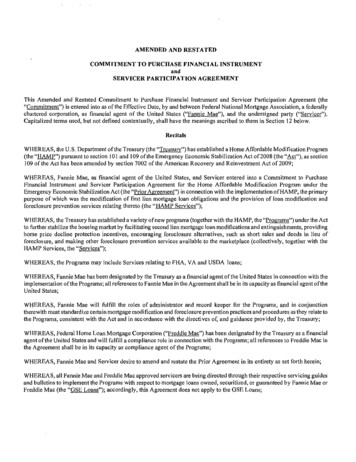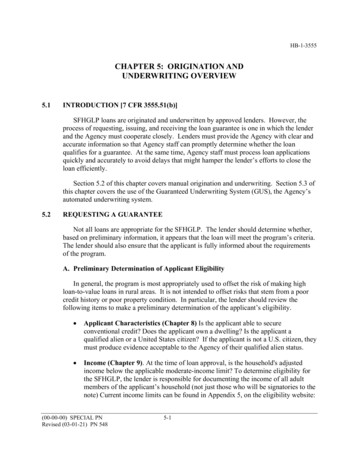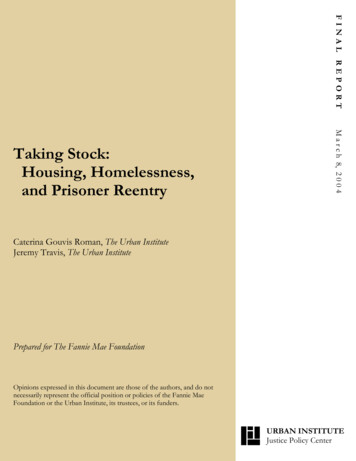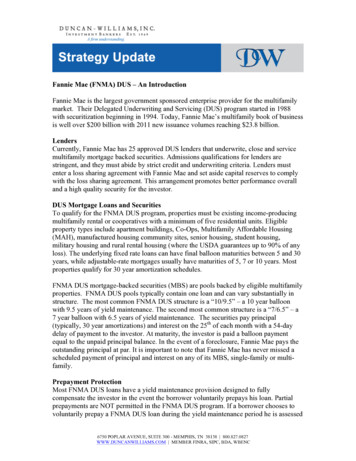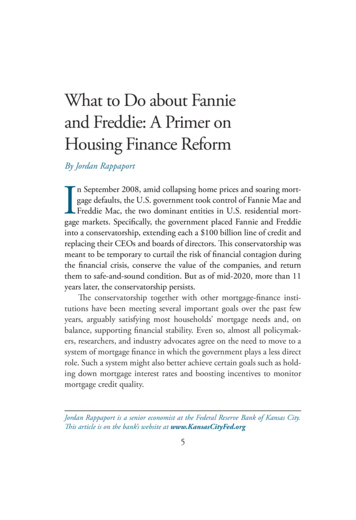
Transcription
What to Do about Fannieand Freddie: A Primer onHousing Finance ReformBy Jordan RappaportIn September 2008, amid collapsing home prices and soaring mortgage defaults, the U.S. government took control of Fannie Mae andFreddie Mac, the two dominant entities in U.S. residential mortgage markets. Specifically, the government placed Fannie and Freddieinto a conservatorship, extending each a 100 billion line of credit andreplacing their CEOs and boards of directors. This conservatorship wasmeant to be temporary to curtail the risk of financial contagion duringthe financial crisis, conserve the value of the companies, and returnthem to safe-and-sound condition. But as of mid-2020, more than 11years later, the conservatorship persists.The conservatorship together with other mortgage-finance institutions have been meeting several important goals over the past fewyears, arguably satisfying most households’ mortgage needs and, onbalance, supporting financial stability. Even so, almost all policymakers, researchers, and industry advocates agree on the need to move to asystem of mortgage finance in which the government plays a less directrole. Such a system might also better achieve certain goals such as holding down mortgage interest rates and boosting incentives to monitormortgage credit quality.Jordan Rappaport is a senior economist at the Federal Reserve Bank of Kansas City.This article is on the bank’s website at www.KansasCityFed.org5
6FEDERAL RESERVE BANK OF KANSAS CITYThis primer reviews the current system of mortgage finance andanalyzes the key issues policymakers face in reforming it, includingwhat to do with Fannie and Freddie. While policymakers have reacheda rough consensus on several key issues, such as allowing the government to continue to help some households finance purchasing homes,they disagree on the share of mortgage lending the government shouldbackstop against widespread defaults and how many companies shouldhave access to the backstop.Section I reviews the U.S. system of financing mortgages for singlefamily homes in the years leading up to and during the conservatorship. Section II describes some strengths and weaknesses of the currentsystem under the conservatorship. Section III discusses the extent towhich the government should backstop residential mortgage lendingand the number of companies that should succeed Fannie and Freddie.I.The U.S. System of Mortgage FinanceFannie Mae—formally, the Federal National Mortgage Association—was established as a federal government agency during the GreatDepression to increase the supply of mortgage funds available acrossthe country. Rather than lending to consumers directly, Fannie Maepurchased mortgage loans from private lenders, typically banks, in the“secondary” mortgage market. In doing so, Fannie Mae increased lenders’ funds so that they could extend new mortgage loans.The loans Fannie Mae purchased were limited to those insured bythe Federal Housing Administration (FHA), meaning the FHA covered any delinquent payments by borrowers and paid off mortgagesin the event of foreclosure. Fannie Mae retained some of the loans itpurchased and pooled others together to sell as securities. Private investors in these mortgage-backed securities (MBS) received monthly cashflows based on borrowers’ payments of principal and interest on themortgages in the underlying pool. The FHA insurance, backed by afull-faith U.S. government guarantee, made these securities very lowrisk and therefore attractive to investors. Following World War II, Fannie also began purchasing loans insured by the recently formed Veterans Administration (VA).Over the following decades, Fannie Mae went through a seriesof transformations. Most importantly, in 1968, Congress rechartered
ECONOMIC REVIEW VOLUME 105, NUMBER 2, 20207Fannie as a government-sponsored enterprise (GSE). Henceforth, Fannie Mae would be a for-profit, shareholder-owned company regulated by the Department of Housing and Urban Development, raisingfunds on public stock and bond markets while retaining its governmentmandate to increase liquidity in secondary mortgage markets. A newgovernment organization known as Ginnie Mae (formally, the Government National Mortgage Association) took over the purchase and securitization of mortgages insured by the FHA and VA.1 Fannie, instead,would purchase only mortgages not insured by the federal government,which it would hold in portfolio. Mortgages eligible for purchase hadto meet two legislated requirements: first, the loan principal had to fallbelow a proscribed maximum; second, borrowers had to either make adown payment above a certain threshold or purchase mortgage insurance that would pay Fannie if the borrowers defaulted. In addition tothese requirements, Fannie itself imposed relatively conservative underwriting standards.Two years later, in 1970, Congress chartered a second housingGSE, Freddie Mac (the Federal Home Loan Mortgage Corporation).Like Fannie, Freddie purchased eligible mortgages from lenders andimposed relatively conservative underwriting standards. But instead ofholding these loans in portfolio, Freddie Mac pooled most of theminto securities that it sold to investors. In return for a fee, Freddie Macguaranteed investors that the securities would pay out as scheduled evenif borrowers missed payments or defaulted. While Freddie Mac statedexplicitly that this guarantee was not backed by the federal government,many investors nevertheless perceived the government’s sponsorshipand regulation as implying that it would backstop Freddie rather thanlet it default on its obligations.Securitizing mortgages proved more profitable than holding themin portfolio, so Fannie shifted to this model during the 1980s, as bothits business and that of Freddie soared. The blue bars in Chart 1 showthat MBS guaranteed by Fannie or Freddie increased from 7 percent ofU.S. single-family mortgage debt in 1980 to 26 percent in 1990. Thegreen bars, which add loans securitized by Ginnie Mae, show that MBSguaranteed by the three firms rose from 17 percent of single-familymortgage debt in 1980 to 41 percent in 1990. Most remaining singlefamily mortgage debt during the 1980s took the form of individual
8FEDERAL RESERVE BANK OF KANSAS CITYChart 1Outstanding Mortgage innie Mae (FHA/VA/USDA)2005Private label20102015Portfolio holdingsSources: Fannie Mae, Freddie Mac, Ginnie Mae, Board of Governors of the Federal Reserve System,and Inside Mortgage Finance.loans held in portfolio by banks and other financial institutions (yellowbars).2The orange bars in Chart 1 show that “private-label” securities became increasingly popular during the 1990s, as Fannie and Freddie’ssuccess begot increasing competition from investment banks. Ratherthan guaranteeing payments, investment banks issued MBS that weresplit into different tranches of seniority: more junior tranches, whichpaid a higher interest rate, absorbed any delinquencies and defaultsbefore the more senior tranches. Some of these private-label securitiesbundled “jumbo” loans—which had principal above the conforminglimit—made to households with good credit. Others bundled “Alt-A”loans to households unable to sufficiently document a steady source ofincome and “subprime” loans to households with poorer credit. Theprivate-label securities, including their most senior tranches, paid ahigher interest rate than Fannie and Freddie securities, compensatinginvestors for the riskiness of the loans and the lack of a perceived government guarantee.Partly in response to the competition from private investmentbanks, Fannie and Freddie took on increasing risk during the early2000s. For example, the share of mortgage loans Fannie and Freddie
ECONOMIC REVIEW VOLUME 105, NUMBER 2, 20209purchased that had down payments of 10 percent or less of the home’sappraised value increased substantially from 2003 to 2007, as did theshare of mortgages with nonstandard features such as an initial periodduring which principal payments were not required (Frame and others 2015). At the same time, borrowers began increasingly relying ona second mortgage to make the down payment on a first mortgage,increasing their indebtedness and thus their risk of default (Davis andothers 2019).3 In addition, Fannie and Freddie bulked up their portfolio holdings of risky Alt-A and subprime MBS, which they judged tobe especially profitable.4 Notwithstanding this shift to a riskier business strategy, Fannie and Freddie continued to hold relatively shallowcapital buffers to absorb losses, rationalized by the low historical defaultrates of loans they had previously securitized. Defaults remained lowduring the early 2000s, reflecting fast home price growth propelled inpart by relaxed mortgage lending standards.The undercapitalization of Fannie and Freddie, the increased riskiness of their portfolios, and the increasingly risky loans they guaranteedwere made possible by lax regulation and investors’ inattention to thefirms’ creditworthiness. First, Fannie and Freddie’s safety-and-soundness regulator at the time, the Office of Federal Housing EnterpriseOversight (OFHEO), lacked the authority to set capital standards orplace Fannie and Freddie into bankruptcy. In addition, the OFHEOwas funded by congressional appropriations and so subject to influenceby elected officials, who typically favored more relaxed lending standards (Frame and others 2015). Second, most investors believed thatthe federal government would backstop Fannie and Freddie againstdefault, partly reflecting the government’s sponsorship and regulatoryoversight and partly reflecting that the expected financial damage froma default by Fannie or Freddie made them “too big to fail.” This beliefin an implicit government backstop dulled investors’ incentive to monitor whether Fannie and Freddie could meet their debt and MBS guarantee obligations and thus removed an important incentive for Fannieand Freddie to temper risk-taking. Estimates suggest that without theimplicit backstop, Fannie and Freddie would have had to pay interestrates on their debt that were 20 to 40 basis points (0.2 to 0.4 percentagepoint) higher (Frame and others 2015).
10FEDERAL RESERVE BANK OF KANSAS CITYHome prices peaked in mid-2006 and then began sharply contracting in early 2007, eventually provoking a wave of mortgage defaults that threatened Fannie and Freddie’s solvency. In response, thegovernment placed both firms into a conservatorship on September 6,2008. Specifically, Fannie and Freddie were placed under the controlof a recently created regulator, the Federal Housing Financing Agency(FHFA), which immediately replaced the chief executives and directorsof each firm. The goal of the conservatorship was to ensure Fannie andFreddie would continue to meet their guarantee and debt obligationsas well as continue to purchase and securitize residential mortgages. Tomake this possible, the U.S. Treasury agreed to inject up to 100 billionin cash to each enterprise (later doubled to 200 billion) as needed tokeep them solvent, in effect making the implicit guarantee explicit. Inreturn for these injections, Fannie and Freddie issued senior preferredstock to the Treasury that paid a 10 percent dividend and gave warrantsto the Treasury to purchase common stock equivalent to 79.9 percentof each company. The firms also agreed to pay an unspecified fee to thegovernment for its funding commitment.Over the remainder of 2008 through the first quarter of 2012, Fannie and Freddie together drew 187.5 billion from the Treasury.5 Thefirms used a portion of these draws to pay the required dividend; inother words, Fannie and Freddie used injections from the Treasury topay the Treasury. Partly to stop this circularity, the FHFA modified thepreferred stock purchase agreement in mid-2012: instead of paying the10 percent dividend, Fannie and Freddie would henceforth pay anyprofits they earned to the Treasury. This “income sweep” also preventedthe firms from building a capital base from retained earnings, whichbecame especially relevant as house prices stabilized and then beganincreasing. As a result of the modified agreement, Fannie and Freddietogether paid the Treasury 301 billion in cumulative profits throughthe end of 2019.Fannie and Freddie remain the two most dominant entities insingle-family residential finance, together guaranteeing almost half ofnewly originated mortgages in 2018. Including loans insured by theFHA, VA, and U.S. Department of Agriculture (USDA), the federalgovernment directly controls entities guaranteeing more than twothirds of single-family residential lending.
ECONOMIC REVIEW VOLUME 105, NUMBER 2, 202011II. Strengths and Weaknesses of the Current SystemThe government’s direct control of the majority of residential mortgage funding has concerned policymakers for a variety of reasons, including possible lack of competition, mispricing of credit, inefficiencies, andexcessive taxpayer-financed support. However, unwinding the conservatorship has proved challenging. Any mortgage-finance system that replaces it will need to balance five competing goals: meeting households’mortgage credit needs, holding down taxpayer support, supporting financial stability, maintaining the flow of new mortgage credit duringfinancial crises, and improving access to affordable housing for low- andmoderate-income (LMI) households. The current system under the conservatorship has several strengths when it comes to meeting these goals;it also has some weaknesses that reforms may be able to address.Meeting households’ mortgage credit needsThe current system of U.S. mortgage finance under the conservatorship and government-insured lending appears, on balance, to bemeeting the mortgage needs of most middle-income households. Inparticular, it lowers interest rates on backstopped mortgages, contributes to the viability of long-term fixed-rate mortgages, and arguably letsmost households with at least moderate creditworthiness access mortgage borrowing. To be sure, high housing prices have made purchasinga home a steep financial challenge. But down-payment requirementsfor FHA loans are low, making the affordability of monthly paymentsthe primary borrowing constraint.One way the current system lowers mortgage interest rates is byeliminating default risk. Specifically, the full-faith U.S. governmentbackstop drives high demand for agency MBS—those guaranteed byFannie, Freddie, or Ginnie—by risk-adverse investors such as insurancefirms and foreign central banks. This high demand increases the marketvalue of individual mortgages eligible to be included in the underlyingpools, in turn allowing lenders to offer lower interest rates to households. When credit markets are functioning normally, this channel isestimated to lower interest rates on conforming mortgages by 30 basispoints relative to rates on ineligible mortgages (Scharfstein and Swagel 2016; Frame and others 2015). During periods of financial stress,
12FEDERAL RESERVE BANK OF KANSAS CITYthis channel lowers relative interest rates on conforming mortgages bysomewhat more.In eliminating default risk, the backstop also lowers borrower interest rates by increasing the market liquidity of agency securities. Theliquidity of a market—the ease of matching buyers and sellers—depends on the substitutability of the traded securities. For some securities, such as a specific company’s common stock, the traded shares areidentical and thus considered perfect substitutes. In contrast, agencyMBS with the same identifying characteristics—such as the specificguarantor (Fannie, Freddie, or Ginnie), interest rate on face value, andmaturity—are not identical: instead, each security represents a differentmortgage pool made up of multiple individual loans. By eliminatingdefault risk, the backstop allows investors to trade agency MBS with thesame identifying characteristics without scrutinizing the credit qualityof underlying pools. The resulting substitutability has been sufficientlyhigh to make the agency MBS market one of the most liquid in theworld.6 Chart 2 shows that the average daily trading volume of agencyMBS, a measure of liquidity, dwarfs the daily volume of U.S. corporateand municipal securities. Estimates suggest that this high liquidity lowers borrower interest rates by 10 to 25 basis points during normal timesand by somewhat more during times of financial stress (Vickery andWright 2013).In addition to lowering interest rates, the high liquidity of theagency market also contributes to the viability of long-term fixedrate mortgages, which are far and away the most popular mortgagetype in the United States but are widely available in only one othercountry, Denmark (Wachter and Tracy 2016; Wachter 2018). For adepository institution, lending at a fixed interest rate for a long duration, such as 30 years, incurs high risk: rising rates can considerablylower the value of such loans, thereby eroding the depository’s capitalbase. An important feature of long-term fixed-rate mortgages in theUnited States—borrowers’ ability to pay down principal before scheduled without a penalty—exacerbates this interest rate risk. Because ofthe prepay option, borrowers often refinance their mortgages followingdeclines in interest rates, eliminating lenders’ potential to profit fromdownswings. However, the high liquidity of the agency market allows U.S.lenders to immediately and inexpensively offload interest-rate and
ECONOMIC REVIEW VOLUME 105, NUMBER 2, 202013Chart 2Average Daily Trading Volume (2015–19)600Billions of U.S. dollarsBillions of U.S. encyCorporateMunicipalSources: Financial Industry Regulatory Authority Trade Reporting and Compliance Engine, Securities Industry andFinancial Markets Association, Federal Reserve Bank of New York, and Municipal Securities Rulemaking BoardElectronic Municipal Market Access.prepayment risks, boosting lenders’ willingness to originate long-termfixed-rate mortgages (Fuster and Vickery 2015; Kanojia and Grant2016). In contrast, mortgages in almost all other countries are characterized by shorter maturities, variable interest rates, and significantpenalties for early payoff.Finally, middle-income households arguably retain ample access tomortgage credit under the current system, though not necessarily because of the government backstop. In 2019, for example, 72 percentof U.S. adults with a credit history had sufficient credit to qualify fora mortgage (Housing Finance Policy Center 2020; Dornhelm 2019).7Similarly, income requirements have remained moderate relative toloan amounts, allowing households to take on considerable debt. Forexample, the median debt service-to-income (DTI) ratio of householdsthat purchased a home in 2019—the sum of monthly payments on allof a household’s borrowing relative to the household’s pre-tax monthly income—was 39 percent (Housing Finance Policy Center 2020).Down-payment requirements have also remained moderate relative tohome purchase prices. The median cash down payment in 2019 was6 percent of a home’s purchase price, and loans insured by the FHA
14FEDERAL RESERVE BANK OF KANSAS CITYrequired a down payment of only 3.5 percent (Housing Finance PolicyCenter 2020).8A possible weakness of the current system’s ability to meet households’ mortgage needs is its lack of competition. The government directly controls all of the agencies with access to its backstop, dullingtheir incentives to compete. A lack of competition may allow Fannieand Freddie to operate inefficiently, increasing guarantee fees paid bylenders, and, in turn, increasing interest rates as lenders pass these feeson to borrowers. Moreover, a lack of competition may allow Fannieand Freddie to become complacent, depressing the innovation of newmortgage products.9Minimizing taxpayer-financed supportThe current system has had mixed success achieving a second keygoal of mortgage finance: minimizing taxpayer-financed spending, especially by reducing the collective liability associated with widespreadmortgage defaults. The FHA has largely been successful in controllingcosts to the taxpayer. Due to the insurance reserve it maintains, fundedby an upfront fee on mortgage originations and a continuing annualfee on unpaid balances, the FHA has only needed to draw from theTreasury once—in 2013 for a relatively modest 1.7 billion—to meetits expected losses. But Fannie and Freddie have been less successful inachieving this goal. Together, the two agencies drew more than 187billion from the Treasury during the financial crisis. While Fannie andFreddie have since paid the government more than 300 billion in dividend payments, the Treasury continues to guarantee 5 trillion of theiroutstanding single-family MBS.In recent years, the FHFA has directed Fannie and Freddie to putin place buffers that can absorb large losses. To do so, in 2013 Fannie and Freddie began contracting with private investors, reinsurancecompanies, and lending banks to cover losses when mortgages in thepools backing MBS default. These “credit risk transfers” (CRTs) include securities Fannie and Freddie sell to private investors, from whomthey receive principal payments when mortgages default; reinsurance,which Fannie and Freddie purchase on pools of mortgages; and lenderrecourse, in which the originators of mortgages retain a portion of thedefault risk.10
ECONOMIC REVIEW VOLUME 105, NUMBER 2, 202015However, as of the end of 2019, the value of CRTs for single-familymortgages was only about 2 percent of Fannie and Freddie’s outstandingguarantees, which is unlikely to cover losses in the event of widespreadmortgage defaults.11 During the Great Recession, Fannie and Freddie’slosses on single-family mortgages approximated 5 percent of guaranteedvalue. Taking into account the higher credit quality of recently securitizedsingle-family mortgages, a crisis similar in magnitude to 2007–10 wouldlikely entail losses approximating 3 percent of guaranteed value (Goodman and Zhu 2013).12 Moreover, during periods of financial stress, investor demand for CRTs is likely to wane, forcing Fannie and Freddie to relyprimarily on their own capital to make new guarantees.Financial stabilityThe current mortgage-finance system also has some strengths in addressing the goal of financial stability. Most importantly, the full-faithgovernment guarantee of MBS issued by Fannie and Freddie and loansinsured by the FHA, VA, or USDA—together with their high combined market share—greatly diminishes the possibility that widespreadmortgage defaults would seize up financial markets. The vast aggregatevalue of U.S. residential mortgage debt, approximately 11 trillion in2018, is held in large quantities by numerous financial institutions.During periods when mortgages are rapidly defaulting, investors mayfear the solvency of financial institutions holding considerable mortgage debt and thus be less willing to trade with them. These fears canquickly multiply to include, for example, the solvency of financial institutions that hold little mortgage debt themselves but lend to otherinstitutions that do. Concerns about financial markets seizing in thismanner helped drive the Treasury’s 2008 decision to rescue Fannie andFreddie.13 Backstopping a large share of single-family lending lowers theamount of risky mortgage assets held by financial institutions, makingmarkets less likely to seize.A potential weakness of the current system in terms of financialstability are the dulled incentives to monitor Fannie and Freddie’s creditquality (described in Section I). However, the credit quality of Fannieand Freddie’s loan pools as of mid-2020 appear to remain high. Onereason for this relatively high credit quality may be the political pressure to avoid another rescue and the associated careful scrutiny by the
16FEDERAL RESERVE BANK OF KANSAS CITYFHFA. A second reason may be careful scrutiny by investors in Fannieand Freddie’s CRTs. A third reason may be lenders’ caution to avoidliabilities for poor underwriting, which regulators imposed followingthe housing crisis.Maintaining the flow of new mortgage credit during periods of financial stressAnother strength of the current system is that the governmentbackstop critically contributes to keeping new mortgage credit flowingwhen financial markets are stressed, helping to stave off a collapse of residential investment. Maintaining the flow of mortgage credit also helpstransmit monetary policy easing, allowing homeowners to refinance atlower interest rates. Currently, backstopped lending can quickly scaleup to meet most demand for mortgage lending. During the financialcrisis, mortgages insured by the FHA, VA, or USDA, together withmortgages securitized by Fannie or Freddie, nearly doubled in value.Chart 3 shows that from 2006 to 2009, the share of origination valueaccounted for by these mortgages jumped from 35 to 97 percent.14A corresponding weakness, however, is that a significant share ofthe ramped-up lending during times of financial stress may be for unduly risky transactions. For example, Fannie and Freddie significantlyincreased mortgage purchases in the year leading up to the financialcrisis to replace withdrawn funding from other channels. Loans withapproximately 12 percent of the value of the ramped-up purchaseseventually defaulted, up from less than 2 percent of the value of loanspurchased by Fannie and Freddie in each year from 1999 through 2002(Goodman and Zhu 2013).Access to affordable housingFinally, the current system of backstopped lending provides somesupport for affordable housing for LMI households. The FHA, for example, has historically focused on insuring loans to first-time homebuyers, LMI households, and households with credit histories that makethem ineligible for Fannie and Freddie securitization (CongressionalResearch Service 2019). For these mortgages, the FHA requires a downpayment of just 3.5 percent. In addition, Fannie and Freddie have longhad to meet annual affordable housing goals specifying a minimumshare of securitized mortgages that fund the purchase of single-family
ECONOMIC REVIEW VOLUME 105, NUMBER 2, 202017Chart 3Newly Originated Single-Family innie Mae (FHA/VA/USDA)2010Private label20132016Portfolio holdingsSources: Fannie Mae, Freddie Mac, FHA, VA, USDA, private mortgage insurers, and Inside Mortgage Finance.homes occupied by LMI households or located in LMI neighborhoods.15In 2015, Fannie and Freddie also began collecting a small fee for useby government agencies supporting affordable housing. In 2016, theywere obligated with a “duty to serve” LMI households in several underserved markets, for example by encouraging lenders to extend mortgagefinancing and liaising with housing development organizations.16Despite this support, the success of the current mortgage-financesystem in improving access to affordable housing by LMI householdsis unclear. On the one hand, FHA insurance and guarantees by Fannieand Freddie have helped millions of LMI households obtain mortgagefinancing. On the other hand, single-family home prices remain highfor many households, in part reflecting the current system’s widespreadaccess to mortgage financing.17 Renting an apartment is typically lessexpensive and thus may be a better option for many LMI households.Lending programs focused on increasing the supply of less-expensiverental apartments may be more effective in improving LMI households’access to affordable housing than lending programs focused on improving LMI households’ access to mortgage financing. The FHA, Fannie,and Freddie currently have a number of such programs.
18FEDERAL RESERVE BANK OF KANSAS CITYIII. Reforming Mortgage FinanceMany of the strengths of the current system of mortgage finance—including relatively low borrower interest rates, the widespread availability of long-term fixed-rate mortgages, and the continued flow ofnew credit during periods of financial stress—at least partly depend onthe government backstop. Thus, any plan to end the conservatorshipwill likely retain at least a portion of it. However, questions remain overthe appropriate “footprint” of the government backstop as well as howmany guarantors—entities such as Fannie and Freddie that guaranteemonthly MBS payments to bondholders—should have access to it. Theanswers to these questions will determine how successful any new system of mortgage finance will be in meeting the five goals discussed inthe previous section.The backstop footprintA broad consensus holds that the government should continue tobackstop at least some residential mortgage debt (Wachter 2018; Brightand DeMarco 2016; Wallison and Pinto 2018; Fisher and others 2018).But policymakers disagree on the ideal size of the backstop footprint.The current footprint constitutes mortgage-backed securities guaranteed by Fannie and Freddie as well as government-insured lending viathe FHA, VA, or USDA. Most remaining residential mortgages are either held in portfolio by financial institutions or securitized in privatelabel offerings.The size of the backstop footprint relative to other mortgage lending is primarily determined by three factors: eligibility criteria for backstopped loans, capital requirements for existing or new guarantors, andfees the government charges guarantors, lenders, and households for access to the backstop. Tight eligibility criteria, high capital requirements,and high government fees narrow the footprint. Relaxed eligibility criteria, low capital requirements, and low government fees broaden it.The three factors indirectly affect mortgage-finance goals by increasingor decreasing the size of the footprint. However, they each also directlyaffect mort
"secondary" mortgage market. In doing so, Fannie Mae increased lend - ers' funds so that they could extend new mortgage loans. The loans Fannie Mae purchased were limited to those insured by the Federal Housing Administration (FHA), meaning the FHA cov-ered any delinquent payments by borrowers and paid off mortgages in the event of .

